
Time management in software development is crucial since it helps to deliver projects on time, build customer relationships, maintain team health, and maximize profits. Basically, project management in any industry makes no sense without an account for time: people, budgets, deadlines – all will crumble like a house of cards.
Let’s explore the key time management challenges in software development and learn how to prevent and handle project delays effectively.
Common Causes of Software Project Delays + Solutions
1. Insufficient time and effort in planning
Poor project planning is one of the primary causes of project delays. It often stems from the belief that project execution is where the value is created. Therefore, there’s no point in detailed project planning. In reality, scope development, risk analysis, software development time and cost estimation, and other components of accurate software project planning are the pillars on which your project stands and your recipe for project success.
“If I had 8 hours to chop down a tree, I would spend 6 hours sharpening my axe.” — Abraham Lincoln
How do you expect your team to deliver on time when you haven’t developed a well-rounded project schedule, discussed and documented time estimates, and calculated project cost and its variation? What do you do if one of the team members leaves and you neither have other available resources, nor a contingency plan?
Solutions:
- Agile planning: Agile is a project management methodology that emphasizes flexibility, collaboration, and continuous feedback. Agile planning focuses on breaking a project down into smaller, more manageable chunks called sprints. Each sprint typically lasts a few weeks and involves planning, development, and testing. Agile planning helps teams to stay focused, manage changes effectively, and continuously adapt to changing requirements.
- Critical Path Method (CPM): The critical path is the sequence of tasks that must be completed in order to finish the project on time. CPM involves creating a network diagram of all the tasks involved in the project and using that diagram to identify the critical path. By focusing on it, you can prioritize your efforts and ensure that the team is working on the most important tasks.
- Work Breakdown Structure (WBS): WBS involves creating a hierarchical list of all the tasks involved in the project, starting with the largest tasks at the top and breaking them down into smaller sub-tasks. By breaking the project down into smaller pieces, you can more easily manage your project, assign tasks to team members, and monitor progress.
Get a free WBS template here. 👈
2. The planning fallacy
Overly optimistic time estimates result in various negative implications, from increased work pressure and poor efficiency to a complete project failure. During the project planning phase, managers tend to stick with optimistic scenarios or not take into account risks and implications, thus sticking with overly optimistic estimates and making project execution a much harder task than it really is.
“What can go wrong, will go wrong.” — Murphy’s Law
Do you use tracking time to measure developer performance and ensure compliance with the project schedule? Do you build performance reports regularly to track team health? Do you track estimated time vs. actual time to identify bottlenecks and gather historical data for more accurate project estimation? Do you have a time tracking system in place that does all this job for you and relieves you from managing dozens of spreadsheets?
Solutions:
- Historical data analysis: By examining past software projects that are similar in scope and complexity, developers can get a realistic estimate of the time and resources needed for the new project. Historical data analysis helps to avoid making assumptions and relying on overly optimistic predictions. It also assists in identifying potential roadblocks and challenges that may affect the project’s timeline and budget.
- Milestone-based estimating: Milestone-based estimating involves breaking down the project into smaller, manageable phases or milestones. Each milestone includes specific tasks and deadlines that developers need to achieve. This approach enables you to track progress effectively, assess risks, and make adjustments when needed. Milestone-based estimating also allows you to prioritize tasks and allocate resources more efficiently, which can reduce the chances of missed deadlines and unexpected cost overruns.
- Expert judgment: Expert judgment involves seeking input from individuals who have experience in similar software development projects. These experts can provide valuable insights and identify potential pitfalls that developers might not consider otherwise. Expert judgment helps to validate the estimates and assumptions used in the planning process, ensuring that all factors are considered. Additionally, consulting experts can help to reduce the chances of bias and groupthink, ensuring that the project remains on track.
Explore other handy project estimation techniques here. 👈
3. Ineffective project progress tracking
Ineffective project progress tracking is another common cause of software project delays. Software project managers are responsible for reviewing performance status reports, milestone completion, and regularly checking with the project plan but without the right tools, they risk missing out on bottlenecks and scope creep, burned out developers, and drown in a slew of spreadsheets.
“When performance is measured, performance improves. When performance is measured and reported back, the rate of improvement accelerates.” – Pearson’s Law
Do you use tracking time to measure developer performance and ensure compliance with the project schedule? Do you build performance reports regularly to track team health? Do you track estimated time vs. actual time to identify bottlenecks and gather historical data for more accurate project estimation? Do you have a time tracking system in place that does all this job for you and relieves you from managing dozens of spreadsheets?
Solutions:
- Establish clear, measurable milestones: Each milestone should be tied to specific deliverables, objectives, and key performance indicators (KPIs) to help measure progress. By regularly reviewing and updating these milestones, project managers can get a clear picture of where the project stands and identify areas that need attention.
- Foster a culture of transparency: This means encouraging open communication and collaboration among team members and promoting a shared understanding of project goals and progress. By doing so, you can gain greater insight into team dynamics and progress, which helps to identify and address any arising issues more quickly and efficiently.
- Use automated progress tracking software: It not only helps to track progress but also allows teams to automate some project management tasks, such as time tracking and collaboration. With the aid of automation, you can access real-time data on all aspects of the project, from code quality reviews to design changes. This allows you to monitor progress more efficiently and, at the same time, ensures that all team members are aware of the current status of the project. Additionally, since the software tracks the data itself, it reduces the possibility of errors and inconsistencies that are often associated with manual entry.
4. Customer approval issues
Software project delays may also happen due to approval issues. Without timely communication and project progress report provision, receiving customer feedback may take longer than expected, especially if project performance is below expectations. Every change in the course of the project and every missed chance of communication brings your project closer to delay and even closure.
“The need to communicate effectively with your customers will come up again and again” – Bill Gates
The most effective means of communication with customers is figures. Is your project running according to the schedule? If not, why? Which activities required more time to complete? Which activities were completed earlier than estimated? How did those changes in schedules affect the project cost, and if negatively, what can you do about it?
Solutions:
- Communicate with clients regularly: Developers must have clear and frequent communication with their clients to ensure that they understand the client’s requirements and expectations. Communication can be in the form of regular status updates, meetings, progress reports, and demos. Clients should have a clear picture of how the development team is working to meet their needs and how their feedback is being integrated into the product.
- Stay Agile: Agile development focuses on rapid iteration and feedback, which means that customers can see progress on their project quickly and provide feedback early in the process. This approach also means that developers can make adjustments as they go, rather than waiting until the end of the project to identify issues.
Find out more about Agile project management and how it helps with customer approvals here. 👈
5. Losing key development team members
The software development industry is dynamic, and so are the moods and professional interests of developers. Switching a company after only a year of employment or even less is very common among developers. Projects may run even longer so you need to account for the risk of losing your talents somewhere in between.
“Train people well enough so they can leave, treat them well enough, so they don’t want to.” — Richard Branson
In this regard, you need to account for developer interests and regularly check out their professional development, job satisfaction, and productivity and use this knowledge to the benefit of your project and team. The last thing you want is to learn that any of your developers is overloaded, burned out, or is leaving next week. Do you work closely with the HR team to check out team health and prepare contingency plans to handle this risk effectively?
Solutions:
- Offer competitive compensation and benefits: Software developers are in high demand, and top talent can be difficult to retain without offering competitive pay and benefits. Companies should conduct regular salary and benefit surveys to ensure that their compensation packages remain competitive. Additionally, companies can offer other perks, such as paid time off, opportunities for professional development, and wellness programs, to help attract and retain top talent.
- Foster a positive company culture: A strong company culture can help keep employees engaged and motivated, even in the face of challenges and setbacks. Companies can foster a positive company culture by promoting teamwork and collaboration, recognizing employees for their contributions, and offering opportunities for growth and development. By creating a positive company culture, companies can help ensure that their employees feel valued and supported, reducing the risk of turnover.
- Prioritize work-life balance: The long hours and high-stress environment of software development can quickly lead to burnout and disengagement. To prevent this, companies must prioritize work-life balance. This may involve implementing flexible schedules, offering remote work options, and encouraging employees to take time off when they need it. This way, you can ensure that their employees remain engaged and motivated, reducing the risk of turnover.
Learn how to deal with employee turnover here. 👈
6. The gold plating phenomenon
Gold plating refers to adding extra functionality to the project, which hasn’t been defined in the original scope (and thus hasn’t been approved by the client). In other words, gold plating is giving the customer more than it was originally agreed on. The consequences of such decisions are severe: bloated project scope, profit losses, missed deadlines, excessive pressure and dissatisfaction in the team, and finally, project delay or failure.
“Perhaps too much of everything is as bad as too little.” — Edna Ferber
Why did you make a decision to overdeliver in the first place? Are you trying to go above and beyond to please your client? Or show off your team abilities so that they stick to working with you? Are you doing business with your clients, or are you seeking approval from them at the cost of project profit?
Solutions:
- Clearly define the project scope and requirements: Clear and concise communication between stakeholders, product managers, and development teams is crucial. It can significantly reduce the chances of gold plating occurring during a project. Applying a structured approach to defining project scope and requirements can help minimize the potential for unnecessary features and functionality. Project managers should ensure that they establish project goals at the outset, keep track of progress to ensure that budget and time goals are aligned.
- Keep testing and quality control processes consistent: Quality control in software development is essential to maintaining good work practices. By using established methodologies and processes to ensure that code is robust and reliable, you can minimize the potential for gold plating. One way to optimize your quality control is to keep a consistent testing schedule throughout the development life cycle. Testing should be performed at each development phase, and each feature should be well-documented. Developers must ensure that the code meets established quality standards before releasing the software to end-users.
Explore how to standardize and optimize your project management processes here. 👈
Benefits of Effective Time Management in Software Development
Most of the causes of software project delays boil down to ineffective time and cost management. The good news is that time and cost are interconnected: if you get your team to track their time, you can get an accurate representation of expenses, billing amounts, profits, and losses.
With time tracking alone, you and your development teams achieve the following benefits:
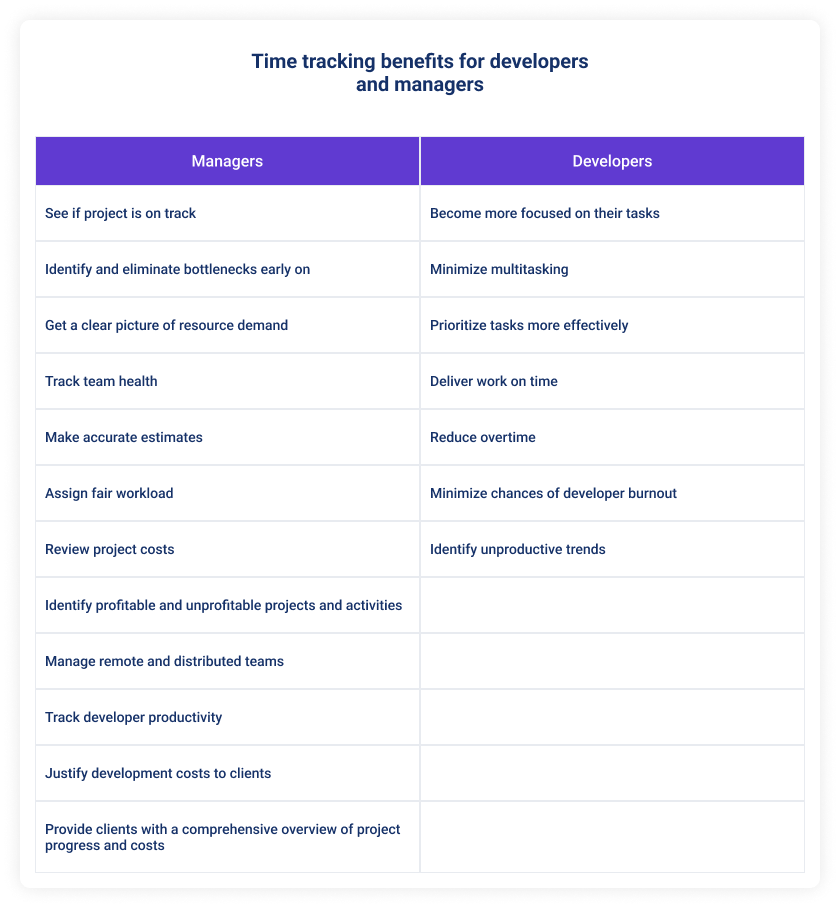
Now, let’s see how proper time management in software development can help you deliver projects on time, mitigate risks, maintain team health, and build solid relationships with customers.
How to Improve Time Management in Software Development: Bonus Tips
1. Implement project management software
After all project activities, estimates, and milestones have been calculated and approved by the customer, we recommend you transfer this data to project management software for effective project progress tracking and reporting. Luckily, modern solutions like actiTIME allow you to import tasks from a file or set the system up in a few clicks.
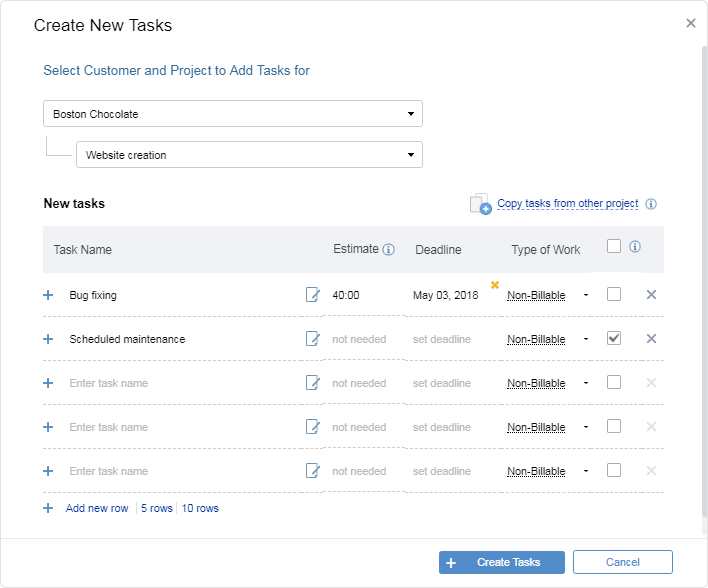
Quickstart in actiTIME: set up customers, projects, tasks, estimates, deadlines, and work rates – all in a single interface
2. Assign work across the team
After you’ve transferred all project activities to the system, it’s time to assign work according to the project schedule. Assigning project tasks to the team members is not enough: you need to make sure that no team member is under- or overbooked. Project management systems for software projects allow you to review the workload of every user and ensure a fair workload for each team member.
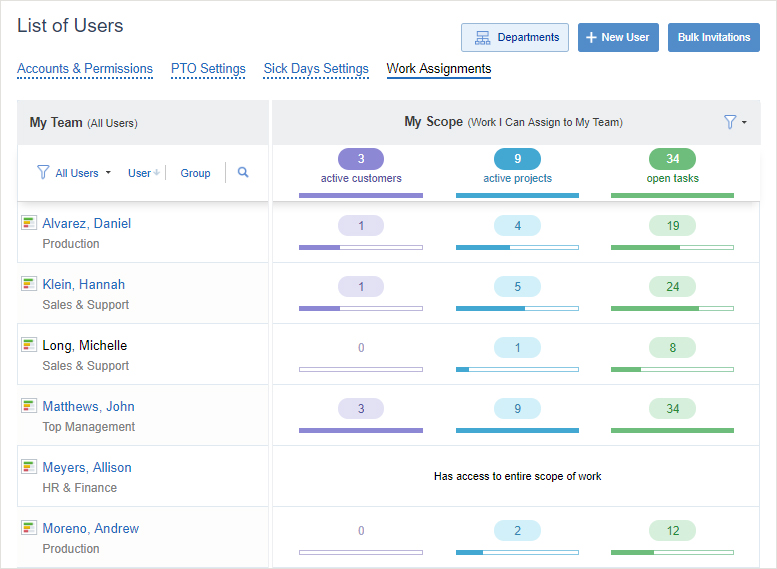
Use the Work Assignments interface in actiTIME to distribute a fair amount of work
3. Get developers to track their time
Without managing time, you lose the grasp of the project’s progress and costs, so it’s important that your team members record time against activities assigned to them and update their current status. Most developers feel resistant to filling out timesheets and recording their activities down to the minute. Make sure that implemented time tracking solution supports various ways of recording time: timesheets, calendars, browser extensions, and software integrations.
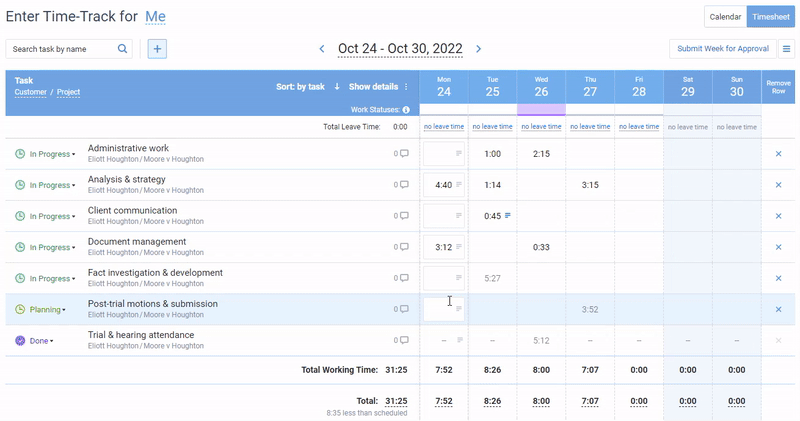
Track time in actiTIME by entering task duration or logging the start and end times of tasks using an online timesheet or weekly timeline view
4. Track project progress
When the work is in progress, you need to look out for bottlenecks and address them in a timely manner. Review your Kanban board regularly to check out task status and make sure that no project activities are blocked. With time tracking software, you can easily see activity status, time expenses against the estimated hours, deadline dates, and more.
Kanban board in actiTIME, where you can click on any task to review spent hours against estimated values, deadlines, comments, and other project activity metrics
5. Check project and team health
Another way to track project progress and team performance is to review productivity analytics. For example, in actiTIME, you can set up widgets with productivity metrics of your choice. See how working and leave time stacks, identify team performance trends, and refer to detailed productivity reports to see time-based performance analytics of individual users.
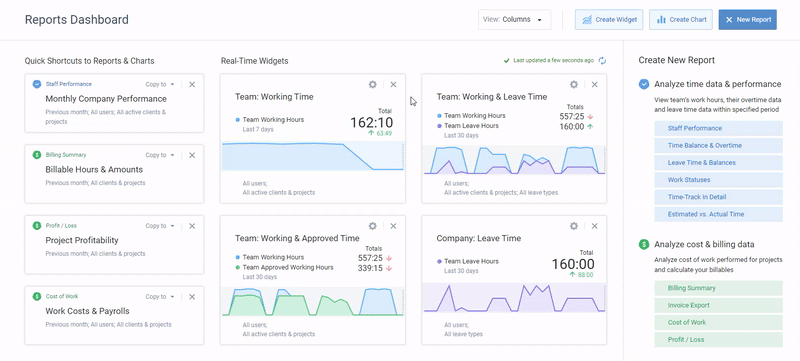
Customizable widgets and reports in actiTIME displaying real-time statistics across selected users, projects, and periods
6. Review project status in detail
Is your project moving forward according to the schedule? How is your team performing against estimates? Which project activities required more or less time than estimated? Look into this data to identify ineffective management solutions, help underperforming developers, and recognize top performers.
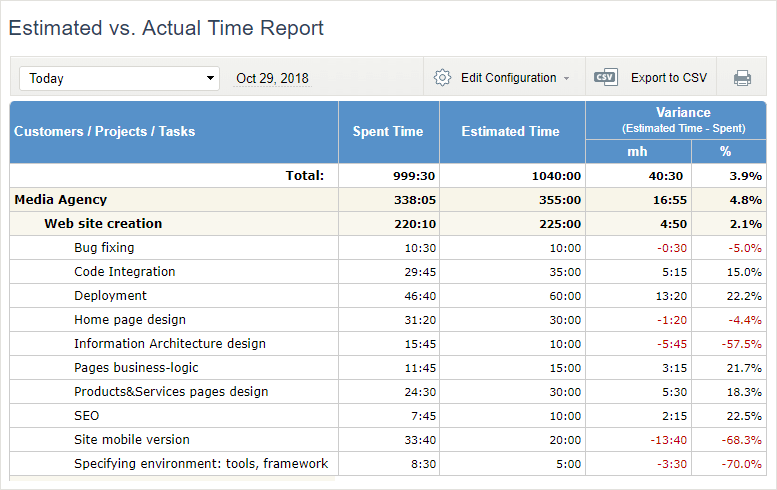
Track project progress compliance with the project schedule in actiTIME
7. Share billing reports with customers
Solid customer relationships are built on trust, and trust in business is achieved through transparent communication. With accurate time tracking data and billing rates for different types of project activities, you can get the most precise cost breakdown to justify the project cost to the client.
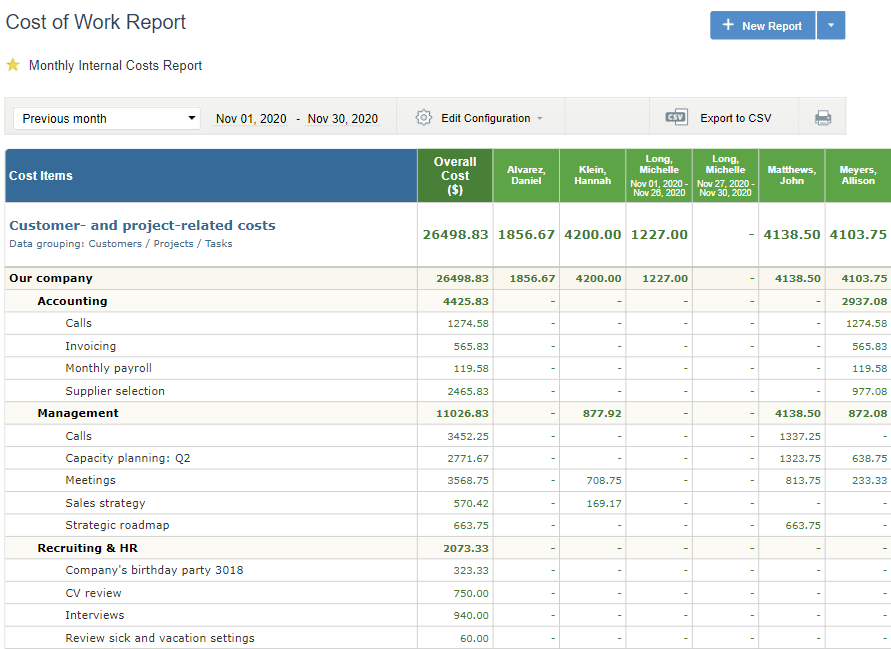
Get project time and cost breakdown in actiTIME
8. Monitor project profitability
Profitability analysis is an important part of project management. Without regular profitability monitoring, you can’t be sure that a project is worth time, effort, and resources. Scope creep and other factors can impact project profitability or reduce the profitability of individual project activities. Luckily, with modern project management software, you can access real-time analytics anytime.
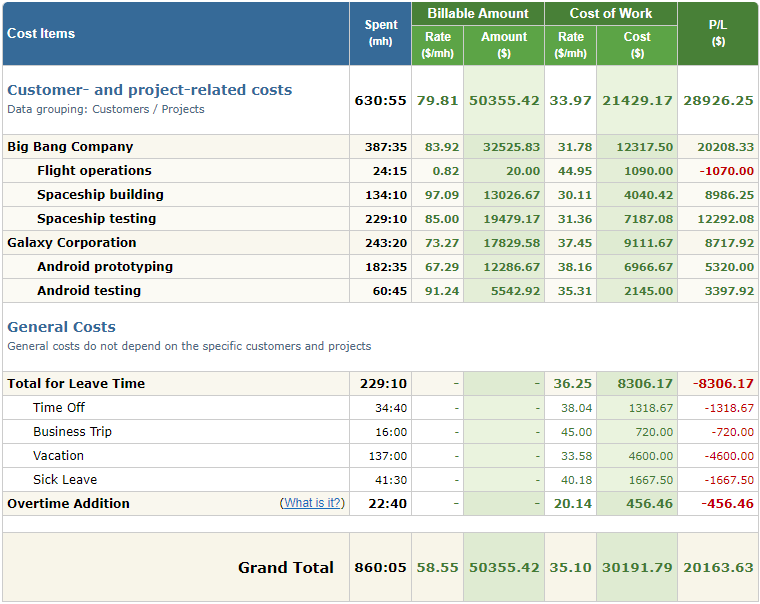
Identify unprofitable projects and activities in actiTIME
Ready to Get Better at Time Management in Software Development?
In the IT industry, everything comes down to software: project management, software development, communication – you name it. Since transparent and accurate data constitute customer trust, automated project management systems minimize time on manual maintenance and save time for leading project teams to success. The question is, what software can meet the needs of software projects?
One of the project management software for software projects to consider is actiTIME. It boasts support for Agile, Waterfall, and other methodologies and an extensive set of developer software extensions.

actiTIME allows tracking time and work progress using:
- Traditional weekly timesheets
- The calendar view
- A fully automated browser extension
- A mobile app
It provides helpful user interfaces displaying estimates and deadlines, custom task parameters, and more. At the same time, managers get access to granular work scope, project, cost management, leave tracking, and user permission settings – this is not the exhaustive list of things to fine-tune in actiTIME for simple and handless project tracking. Give it a try – start with a free 30-day trial (no credit card required) and continue with a free plan anytime.


















































